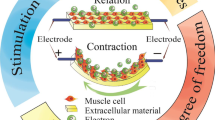Abstract
The need for computer aided engineering in the analysis of machines and mechanisms led to a wide variety of general purpose programs for the dynamical analysis of multibody systems. The use of more lightweight structures and an increasing demand of high-precision mechanisms, such as robots, led to the incorporation of flexible bodies in this methodology. This paper presents a formalism for flexible multibody systems based on a minimum set of generalized coordinates and symbolic computation. A standardized object oriented data model is used for the time-invariant system matrices describing the elastodynamic behaviour of the flexible bodies. Consequently, the equations of motion are derived in a form independent of the chosen modelling technique for the elastic bodies. They are generated in a symbolic form using the symbolic formalismNEWEUL and the computer algebra systemMAPLE. Two examples, a rotating beam and a flexible robot, are presented in this paper in order to demonstrate the formalism.
Similar content being viewed by others
References
Ambrósio, J. A. C. and Nikravesh, P. E., ‘Elasto-plastic deformations in multibody dynamics’,Nonlinear Dynamics 3, 1992, 85–104.
Banerjee, A. K. and Dickens, J. M., ‘Dynamics of an arbitrary flexible body in large rotation and translation’,AIAA Journal of Guidance 13(2), 1990, 221–227.
Beltzer, A. I.,Variational and Finite Element Methods: A Symbolic Computation Approach, Springer-Verlag, Berlin, 1990.
Belytschko, T. and Hsieh, B. J., ‘Nonlinear transient finite element analysis with convected coordinates’,International Journal for Numerical Methods in Engineering 7, 1973, 255–271.
Brackx, F. and Constales, D.,Computer Algebra with LIPS and REDUCE, Kluwer Academic Publishers, Dordrecht, 1991.
Cardona, A. and Geradin, M., ‘A beam finite element non-linear theory with finite rotation’,International Journal for Numerical Methods in Engineering 26(11), 1988, 2402–2438.
Char, B. W., Geddes, K. O., Gonnet, G. H., Leong, B., Monagan, M. B., and Watt, S. M.,First Leaves: Tutorial Introduction to Maple, Springer-Verlag, New York, 1992.
DeSalvo, J. G. and Gorman, R. W.,ANSYS Engineering Analysis System User's Manual, Swanson Analysis Systems, Houston, 1989.
Gear, C. W.,Numerical Initial Value Problems in Ordinary Differential Equations, Prentice Hall, Englewood Cliffs, 1971.
Ider, S. K. and Amirouche, F. M. L., ‘Nonlinear modelling of flexible multibody systems dynamics subject to variable constraints’,Journal of Applied Mechanics 56, 1989, 444–450.
Ioakimidis, N. T., ‘Elementary applications of MATHEMATICA to the solution of elasticity problems by the finite element method’,Computer Methods in Applied Mechanics and Engineering 102, 1993, 29–40.
Jenks, R. D. and Sutor, R. S.,AXIOM. The Scientific Computation Systems, Springer-Verlag, Berlin, 1992.
Kane, T. R., Ryan, R. R., and Banerjee, A. K., ‘Dynamics of a cantilever beam attached to a moving base’,Journal of Guidance 10(2), 1987, 139–151.
Kim, S. S. and Haug, E. J., ‘Selection of deformation modes for flexible multibody dynamics’,Mechanisms, Structures & Machines 18(4), 1990, 565–586.
Likins, P. W., ‘Finite element appendage equations for hybrid coordinate dynamic analysis’,International Journal of Solids and Structures 8, 1972, 709–731.
Likins, P. W., ‘Geometric stiffness characteristics of a rotating elastic appendage’,International Journal of Solids and Structures 10, 1974, 161–167.
Meirovitch, L. and Kwak, M. K., ‘Convergence of the classical Raleigh-Ritz method and the finite element method’,AIAA Journal 28(8), 1990, 1509–1516.
Melzer, F.,Symbolisch-numerische Modellierung elastischer Mehrkörpersysteme mit Anwendung auf rechnerische Lebensdauervorhersagen, Fortschritt-Berichte der VDI-Zeitschriften, Reihe 20, Nr. 139, VDI-Verlag, Düsseldorf, 1994.
Otter, M., Hocke, M., Daberkow, A., and Leister, G., ‘Ein objektorientiertes Datenmodell zur Beschreibung von Mehrkörpersystemen unter Verwendung von RYST’, Institutsbericht IB-16, Institut B für Mechanik, Universität Stuttgart, 1990.
Rauh, J. and Schiehlen, W., ‘Various approaches for the modelling of flexible robot arms’, inRefined Dynamical Theories of Beams, Plates and Shells and Their Applications, I. Elishahoff and H. Irretier (eds.), Springer-Verlag, Berlin, 1987, pp. 420–429.
Salecker, M., ‘Zur Dynamik hybrider Mehrkörpersystemen — Theorie und symbolische Programmierung’, Ph.D. Dissertation, Faculty of Mechanical Engineering, University of Karlsruhe, Germany, 1991.
Schiehlen, W. O. and Kreuzer, E. J., ‘Symbolic-computerized derivation of equations of motion’, inDynamics of Multibody Systems, K. Magnus (ed.), IUTAM Symposium München, Germany, Springer-Verlag, Berlin, 1978.
Schiehlen, W. (ed.),Multibody Systems Handbook, Springer-Verlag, Berlin, 1989.
Shabana, A. A. and Wechage, R., ‘Variable degree-of-freedom component mode analysis of inertia variant flexible mechanical systems’,Journal of Mechanism, Transmission, and Automation in Design 105, 1983, 371–378.
Shabana, A. A.,Dynamics of Multibody Systems, Wiley, New York, 1989.
Sorge, K., Bremer, H., and Pfeiffer, F., ‘Multi-body systems with rigid-elastic subsystems’, inAdvanced Multibody Systems Dynamics — Simulation and Software Tools, W. Schiehlen (ed.), Kluwer Academic Publishers, Dordrecht, 1993, pp. 195–215.
Wallrapp, O., Santos, J., and Ryu, J., ‘Superposition method for stress stiffening in flexible multibody dynamics’, inProceedings of the International Conference on Dynamics of Flexible Structures in Space, C. L. Kirk and J. L. Junkins (eds.), Springer-Verlag, Berlin, 1990, pp. 233–247.
Wallrapp, O., ‘Standard input data of flexible members in multibody systems’, inAdvanced Multibody System Dynamics — Simulation and Software Tools, W. Schiehlen (ed.), Kluwer Academic Publishers, Dordrecht, 1993, pp. 445–450.
Wolfram, S.,Mathematica: A System for Doing Mathematics by Computer, Addison-Wesley, Reading, PA, 1988.
Author information
Authors and Affiliations
Rights and permissions
About this article
Cite this article
Melzer, F. Symbolic computations in flexible multibody systems. Nonlinear Dyn 9, 147–163 (1996). https://doi.org/10.1007/BF01833298
Received:
Accepted:
Issue Date:
DOI: https://doi.org/10.1007/BF01833298




